| Ecosystem Refresher Course |
| Ecosystem Concepts Files |
| Ecosystem Master Files |
| Ecosystem Revision Note |
| Ecosystem Note 1 |
| Ecosystem Note 2 |
| Ecosystem Reference Book |
Ecosystem
Table of Contents
- What is Ecosystem?
- Ecosystem- Structure and Function
- Productivity
- Decomposition
- Energy Flow in Ecosystem
- Food Chain
- Ecological Pyramid
- Ecological Succession
- Nutrient Cycling
- Ecosystem Services
What is Ecosystem?
- The communication between the living life form and the non-living environment is called Ecosystem.
Ecosystem – Structure and Function
- Interaction of biotic and abiotic parts brings about a physical structure that is normal for every kind of Ecosystem.
- Identification and portrayal of plant and creature species of an ecosystem provides its species composition.
- Distribution of various species vertically possessing diverse levels is called stratification.
- The parts of the ecosystem are believed to work as a unit:
- Productivity
- Decomposition
- Energy stream
- Nutrient cycle
Description of pond as an ecosystem
- The abiotic parts incorporate all broke down organic and inorganic substances and the rich soil store at the base of the lake.
- The sunlight based information, cycle of temperature, length of the day, regulates the rate of capacity of the whole lake.
- The producer (autotrophic) incorporates phytoplankton, some green growth (algae) and the gliding, submerged and peripheral plants found on edge of the lake.
- The consumers are spoken to by zooplankton, swimming freely and basal staying animals.
- The decomposers are the bacteria, fungi particularly inexhaustible at the base of the lake.
Basic events (in terms of function) in an Ecosystem
- Conversion of inorganic into a natural material (Photosynthesis) with the help of producers
- Autotrophs being consumed by heterotrophs
- Decomposition and mineralization of the dead natural matter to discharge them back to be used again by the autotroph
- There is unidirectional stream of vitality towards the higher trophic levels and its dispersal and loss as warmth to the earth
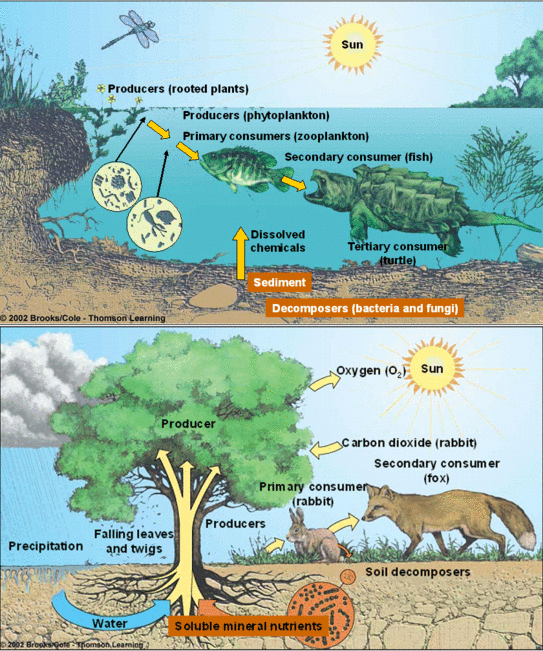
Fig: Pond Ecosystem (above) and Terrestrial Ecosystem (below)
Productivity
Primary Productivity
- The measure of biomass or natural matter created per unit range over a time frame by plants amid photosynthesis
- It is expressed as weight (g-2) or vitality (kcal m-2)
- The rate of biomass generation is called productivity
- Gross primary productivity (GPP): is the rate of creation of natural matter amid photosynthesis.
- Net primary productivity:
- A significant measure of vitality is used by plants while respiration
- Gross primary productivity minus loss through respiration (R) is the net primary productivity.
- GPP – R = NPP
- Net primary productivity is the accessible biomass for the utilization to heterotrophs (herbivore and decomposers)
Secondary Productivity
Secondary Productivity is characterized by the rate of arrangement of new natural matter by the consumer.
Decomposition
- Earthworm is said to be “farmer’s friend”
- Breakdown the intricate natural matter
- Loosening of the soil helps in air circulation and passage of root
- The decomposers decompose complex natural matter into inorganic substances such as nutrients, water, and carbon dioxide, called decomposition
- Remains of dead plants, for example, leaves, flowers, bark remains of dead animals, including fecal matter, constitute the detritus
- The procedure of decomposition is finished in following steps:
- Fragmentation: Breakdown of debris by detritivore (earthworm) into smaller and simpler particles
- Leaching: Inorganic supplements that are water solvent go down into the horizon of the soil and get hastened as inaccessible salts
- Catabolism: Bacterial and parasitic enzymes debase waste into basic inorganic substances
- Humification: Accumulation of amorphous substances that are dark in color is called Humus
The significance of humus
- High imperviousness to microbial activity
- Undergo deterioration at a moderate rate
- Being colloidal in nature, it serves as a repository for supplements
- Mineralization: The humus is further broken down by a few microorganisms and inorganic supplements get released
Factors that affects rate of Decomposition
- Decomposition is generally a process that needs oxygen
- Detritus rich in lignin and chitin has a moderate rate of decomposition
- Detritus rich in substances that are soluble in water like sugar and nitrogen has quicker decomposition
- Temperature and soil dampness are most vital climatic element that regulates decomposition
- Warm and sodden environment support decomposition
Anaerobiosis, dryness and, low temperature restrain decomposition.
Energy Flow in Ecosystem
- Except for remote ocean aqueous ecosystem, the sun is the main source of vitality for all ecosystems on earth
- Less than half of occurrence solar radiation is Photosynthetically Active Radiations. (PAR)
- Plants catch 2-10 % of PAR and utilized as a part of photosynthesis
- All living beings rely on upon the producers, either specifically or by implication
- Flow of energy in the ecosystem is unidirectional i.e. vitality is exchanged from producer to consumers
- Energy exchange is not supreme, and unconstrained unless vitality is degraded it can not be exchanged. At the point when vitality is exchanged starting with one trophic level then onto the next, a significant amount of vitality is lost as warmth to the earth.
- Only 10% of vitality is exchanged from one trophic level to other
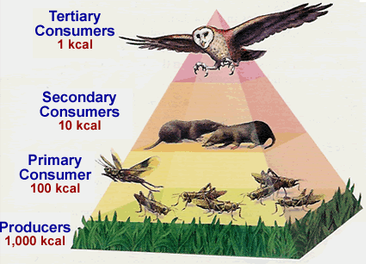
Fig: Energy flow (10% of energy is transferred at successive trophic levels)
Food Chain
- Grazing food chain: it moves from producers through herbivore to meat eater (carnivores)
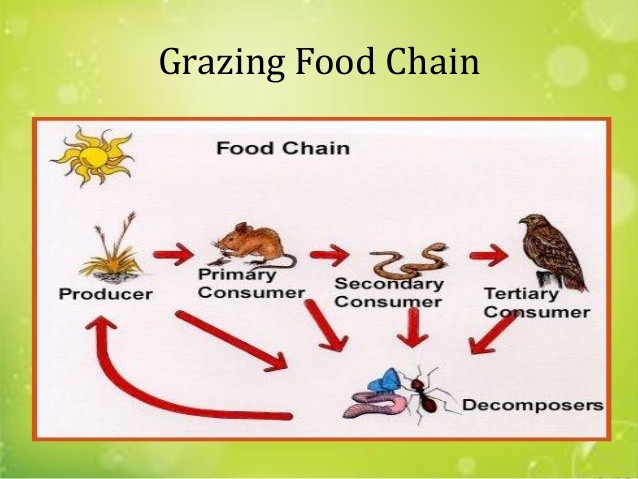
Fig a: Grazing Food Chain
- Detritus food chain: Begins with dead natural matter (detritus) and go through detritus feeding life forms in soil to living beings nourishing on detritus-feeders
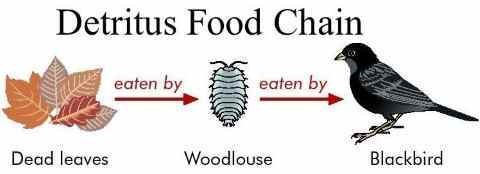
Fig b: Detritus Food Chain
- In oceanic ecosystem GFC is the significant channel for energy flow
- In terrestrial ecosystems a much bigger portion of vitality flows through the detritus food chain than through GFC
- Many different food chains are normally interconnected e.g. a particular herbivore of one food chain may become food of carnivores in other food chains. Such interconnected grid of food chains is called food web
- Trophic level: A gathering of living beings independent of their size having same source of vitality or comparative food propensity constitute a trophic level
- Standing crop: every trophic level has a specific mass of living material at a specific time called as the standing crop
- The standing crop is measured as the mass of living creatures (biomass) or the number in a unit region
- The number of trophic levels in a food chain is confined by 10% flow of vitality, less measure of vitality accessible to the last trophic level
Ecological Pyramid
An ecological pyramid (additionally called energy pyramid, trophic pyramid, or now and again food pyramid) is a graphical representation intended to demonstrate the biomass or bio efficiency at each trophic level in any given ecosystem. The trophic structure and capacity of progressive trophic levels, i.e. Producers → Herbivores → Carnivores, might be indicated graphically by methods called ecological pyramids where the first or producer level constitutes the base of the pyramid and the progressive levels, the levels making the pinnacle. Ecological pyramids were first introduced by Charles Elton (1927) and are, in this manner, additionally called Eltonian pyramids. Ecological pyramids are of three general sorts:
- Pyramid of Energy
- Pyramid of Numbers
- Pyramid of Biomass
Pyramid of Energy
The energy pyramid or the pyramid of energy portrays the general way of the ecosystem. Amid the stream of energy from living forms to other, there is a significant loss of energy as warmth. In primary producers such as the autotrophs, there is more measure of energy accessible. The minimum energy is accessible in the tertiary consumers. Along these lines, the shorter food chain has more measure of energy accessible even at the most elevated trophic level.
- The energy pyramid is constantly upright and vertical
- This pyramid demonstrates the stream of energy at various trophic levels
- It portrays, the energy is least at the most astounding trophic level and is greatest at the most reduced trophic level
- At each trophic level, there is progressive loss of energy as warmth and breath, etc.

Fig. a: Pyramid of Energy
Pyramid of Numbers
The pyramid of numbers portrays the relationship as far as the quantity of producers, herbivores and the carnivores at their progressive trophic levels are concerned. There is an abatement in the quantity of people from the lower to the higher trophic levels. The number pyramid differs from one ecosystem to another ecosystem. There are three forms of the pyramid of numbers:
- Upright pyramid of number
- Partly upright pyramid of number and
- Inverted pyramid of number
Upright Pyramid of Number
Such a sort of pyramid number is found in the grassland and aquatic ecosystem, in these ecosystems there are various little autotrophs which bolster lesser herbivores which thus bolster littler number of carnivores and henceforth this pyramid is upright.
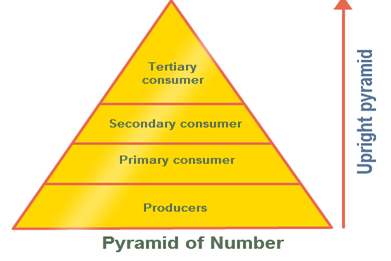
Fig. b: Upright Pyramid of Number
Partly Upright pyramid of Number
It is found in the woodland ecosystem where the quantity of producers are lesser in number and bolster a more prominent number of herbivores and which thus bolster a less number of carnivores.
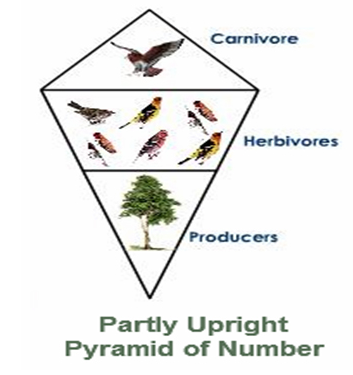
Fig. c: Partly Upright Pyramid of Number
Inverted Pyramid of Number
Such a sort of ecological pyramid is seen in parasitic food chain where one primary producer bolsters various parasites which bolster all the more hyperparasites.
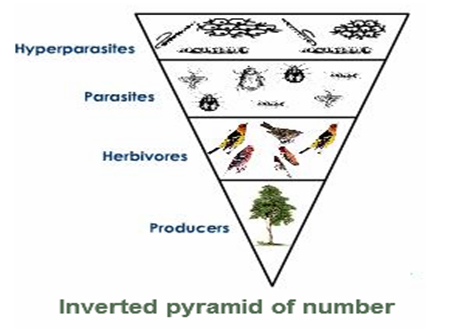
Fig. d: Inverted pyramid of number
Pyramid of Biomass
The pyramid of biomass is more central, they speak of the quantitative connections of the standing crops. In this pyramid, there is a slow decline in the biomass from the producers to the higher trophic levels. The biomass here is gathered from every bolstering level and are then dried and weighed. This dry weight is the biomass and it speaks to the measure of energy accessible as a natural matter of the life forms. In this pyramid, the net dry weight is plotted to that of the producers, carnivores, herbivores, and so on.
There are two sorts of pyramid of biomass, they are:
- Upright pyramid of biomass and
- Inverted pyramid of biomass.
Upright Pyramid of Biomass
Such a case happens when the bigger net biomass of producers maintain a little weight of consumers.
For Example: Forest ecosystem.
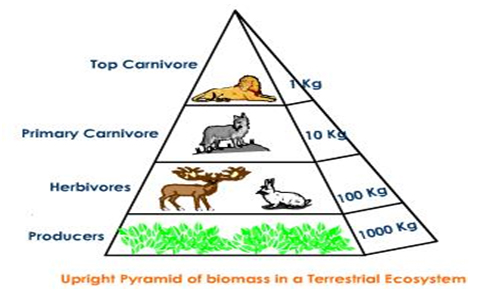
Fig. e: Upright Pyramid of Biomass
Inverted Pyramid of Biomass
Such a case happens when the producer’s smaller weight supports the larger weight of consumers. For example: Aquatic ecosystem.
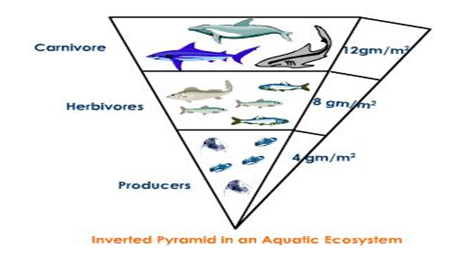
Fig. f: Inverted Pyramid in an Aquatic Ecosystem
Limitations of Ecological Pyramids
- It does not consider similar species having a place with at least two trophic levels
- It expect a basic food chain, it never exits in nature
- It does not oblige food web
- Saprophytes are placed in ecological pyramids
Ecological Succession
- The slow and genuinely unsurprising change in the species piece of a given zone is called Ecological Succession
- Structure and composition of the group always show signs of change because of changing natural condition
- This change is efficient and successive, parallel with the adjustments in the Physical Environment
- All the progressions lead at long last to a group that is in close harmony with the earth and that is called Climax Community
- During succession, a few species colonize and territory and their populations turn out to be increasingly various, though populations of different species decay and even vanish
- The whole sequences of groups that progressively change in a given zone are known as sere
- The individual transitional groups are named as seral stages
- In the progressive seral organizes there is an adjustment in the diversity of species of life forms, increase in number of species and aggregate biomass
Primary Succession:
Primary succession that begins where no living life forms are there- these could be ranges where no living creature ever existed might be an uncovered rock or new water body.
Secondary Succession:
Secondary succession that begins in regions that some way or another, lost all the living beings that existed there.
- Primary succession happens in:-
- newly cooled magma
- bare rock
- newly made lake or repository
- Secondary succession starts in ranges where regular biotic groups have been devastated, for example,
- In deserted homestead lands
- Burned or cut woodland,
- land that has been overflowed
- Since some soil or silt is available, secondary succession is quicker than primary succession
Succession in plants
- Based on the way of living space – whether it is water or it is in extremely dry regions succession of plants is called hydrarch or xerarch
- Hydrarch succession happens in water territories and the successional arrangement progress from hydric to a mesic condition
- Xerarch succession happens in dry territories and the arrangement advance from xeric to mesic conditions
- Both hydrarch and xerarch successions prompt to medium water conditions (mesic) – neither excessively dry (xeric) nor excessively wet (hydric)
Xerarch Succession: Succession in bare rock:
- The species that attacks exposed territory are known as pioneer species
- In primary succession on exposed rock, the pioneer species to be grown is the lichen
- Lichen secretes corrosive materials to break down the rock, leading to weathering and soil development
- The small quantity of soil prompts to the development of bryophytes (greeneries)
- The greeneries accelerate the procedure of soil aggregation by catching wind-blown particles
- Lichen greenery carpet gives reasonable substratum to the germination of seeds of herbaceous plants
- Gradually more soil is aggregated and herbaceous species clear a path for the intrusion of bushes took after by trees
- The climax group is by and large ruled by trees
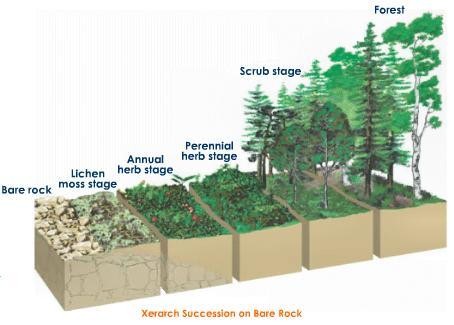
Fig a: Xerarch Succession on Bare Rock
Hydrarch (succession in aquatic environment)
- The pioneer species in primary succession in water are phytoplankton
- Zooplanktons
- Sub consolidated plant organize. (established hydrophytes)
- Sub combined and free-gliding plant stage
- Reed-swamp stage
- Marsh-meadow stage
- Shrub stage
- Trees
- The climax again would be the backwoods
- All the succession whether occurring in water or ashore continues to a comparable climax group – the mesic
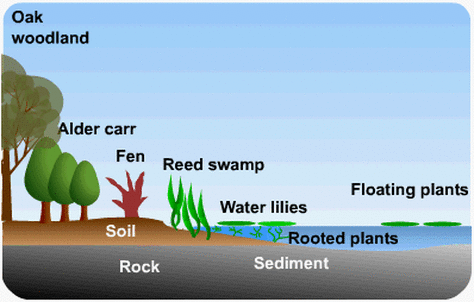
Fig b: Hydrarch Succession Stages
Nutrient Cycling
- Organism needs consistent supply of supplements to develop, divide, and regulate different body capacities
- Standing state: the sum nutrients, for example, carbon, calcium, phosphorus, nitrogen, and so on present in soil at any given time
- Nutrient cycling: The development of nutrient components through the different part of an ecosystem is called nutrient cycling.
- Alternate name of nutrient cycling is Biogeochemical Cycle
- Nutrient cycles are of two sorts:
- Gaseous Cycle
- Sedimentary Cycle
- The store for vaporous kind of nutrient cycle (nitrogen, carbon) exists in the environment
- The store for sedimentary cycle (sulfur, phosphorus) is Earth’s covering
- Environmental variables like soil, pH, dampness, temperature regulate the rate of arrival of nutrient into the climate
- The capacity of the repository is to meet the shortage which happens because of unevenness in the rate of efflux and influx
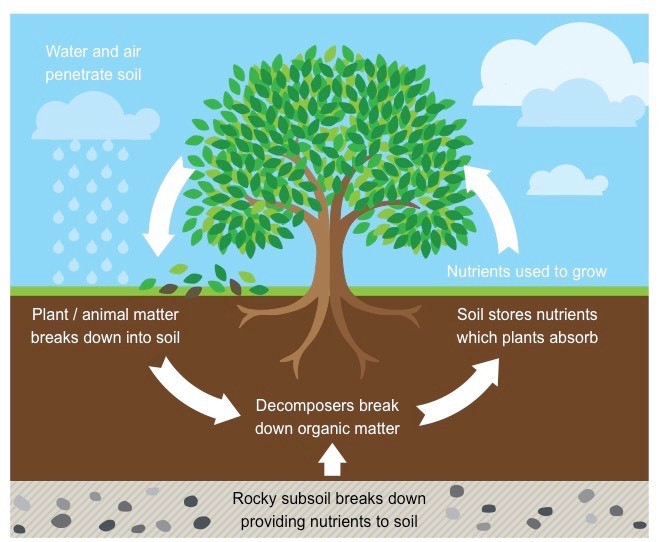
Fig: Nutrient Cycle
Ecosystem – Carbon cycle
- Carbon constitutes 49 % of dry weight of living being
- Out of aggregate worldwide carbon:
- 71 % carbon was discovered broke down in the sea
- About 1 % in the climate
- 4 X 1013 kg of carbon is settled in the biosphere by photosynthesis, every year.
- Large measure of carbon came back to the climate as CO2 through respiratory processes of producers and consumers.
- Decomposers return back the CO2 to the reservoir through the process of decomposition.
- Some measure of Carbon is lost to silt and expelled from the flow.
- Burning wood, backwoods fire, ignition of natural matter, fossil fuel, volcanic exercises are extra hotspots for discharging CO2 to air.
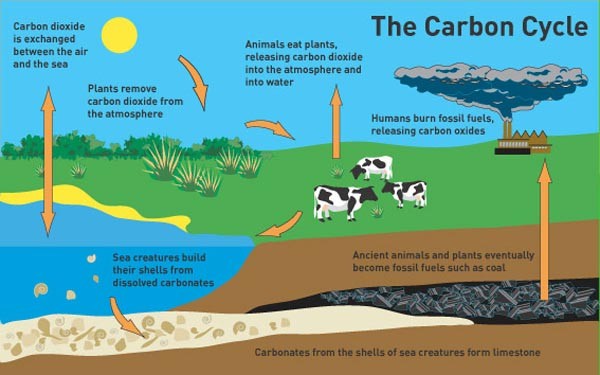
Fig: Carbon Cycle
Influence of human activity on Carbon cycling
- Massive blazing of fossil fuel for vitality and transport
- Rapid deforestation
- Increased the rate of arrival of CO2 into the air
Ecosystem Phosphorus cycle
- Phosphorus is a noteworthy constituent of nucleic acids, cellular membranes and cell vitality exchange system, adenosine triphosphate (ATP)
- Animals require phosphorus to make shells, teeth, and bones.
- Reservoir pool of phosphorus is the stone, which contains phosphorus as phosphates
- During rock weathering, a little measure of phosphates broke up in soil arrangement and are consumed by the underlying foundations that are the roots of the plants
- Herbivore and different animals get the natural type of phosphorus from plants
- The dead life forms and waste products are deteriorated by phosphate-solubilizing bacteria discharging phosphorus
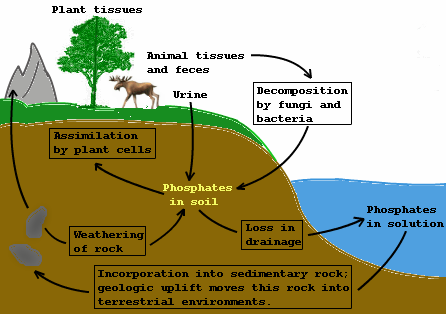
Fig: Phosphorus Cycle
How phosphorus cycle differs from carbon cycle?
- There is no respiratory arrival of phosphorus into the air
- Atmospheric contributions of phosphorus through precipitation are quite small
- Gaseous trade of phosphorus amongst life form and environment are immaterial
Ecosystem Services

Fig: Ecosystem Services
- The results of ecosystem procedures are named as Ecosystem services
- Healthy woods ecosystems sanitize air and water
- Mitigate dry spells and surge
- Cycle supplements
- Generates ripe soil
- Provide natural life territory
- Maintain biodiversity
- Pollinate crops
- Provide capacity site for carbon
- Provides spiritual, social and aesthetic qualities
PAR: Photosynthetically Active Radiation
GAP: Gross Primary Productivity
NPP: Net Primary Productivity
DFC: Detritus Food Chain
GFC: Grazing Food chain